The ‘Bluegrass State’ of Kentucky is a wonderful place to be a birder. With the Cumberland Plateau, the Bluegrass region, and all those hills, mountains, and streams you would be hard put to find a more picturesque place for a little down-home southern bird spotting. Today we will explore what Kentucky offers in the area of bird watching and we’ll let you know some birds that you can see, what they like to eat, and where they ‘hang their hats’ when they are visiting. We’ll sweeten the pot with some hotspots that you can visit as well! Without further ado, let’s talk about those popular backyard birds of Kentucky!
3 Categories – 350+ Birds
Kentucky is home to over 350 species of birds and while that is a little lower than some states you should know that it’s quite a diverse Avian crowd and you might just see some birds here that are not found or very hard to find in any other state. To make it a little easier to find them we’ll divide up a sampling of popular birds by season in this manner:
- Year-round Resident birds
- Birds of Spring, Summer, and Early Fall
- Fall and Winter Birds
Once you know when to look for them then it’s just a matter of knowing where they like to spend their time and which foods might tempt them to come to you! Let’s start with the Kentucky year-round locals!
Kentucky’s Year-round Resident birds
These birds have made Kentucky their home and if you don’t believe it, leave out a little good ol’ Kentucky cornbread outside and then try to tell us that these aren’t southern birds! These feathered friends love the Bluegrass state and may be seen at any time of the year. Let’s see if you can spot one of these birds:
- American Goldfinch
- Mourning Dove
- Red-bellied Woodpecker
- Tufted Titmouse
- American Robin
American Goldfinch – Spinus tristis

Coloration and Markings: The American Goldfinch is a cute little rogue, complete with a cap worn at a jaunty angle! This bird has a bright yellow back, with black wings sporting 2 wingbars as well as some vertical, white lines lower on the inner portions of the wings and extending onto it’s long, black tail. The breast and the underbelly are the same bright yellow but the rump of this bird is white and it extends a little into the underside of the tailfeathers. Facially, this bird has a yellow face, a medium-length, orange, conical bill, and that jaunty cap which we spoke of. It is black and starts at the center of the top of the head and goes down to the bill, as if the bird was wearing it’s ‘hat’ in a rebellious fashion. Females have an olive coloration in place of the black and muted yellows and in winter both genders doff their bright plumage in lieu of a dull brown, though the distinctive wingbars are still there (but dimmed) to give them away.
Size: This bird measures in at 4.3 – 5.1 inches in length with a wingspan of 7.5 to 8.7 inches.
Habitat: Goldfinches love the cover of weeds, briars, and brambles, but they also tend to frequent areas prone to flooding.
Diet: A simple mix of hulled Black Oil Sunflower seeds and Nyjer thistle is a good lure for the American Goldfinch.
Mourning Dove – Zenaida macroura
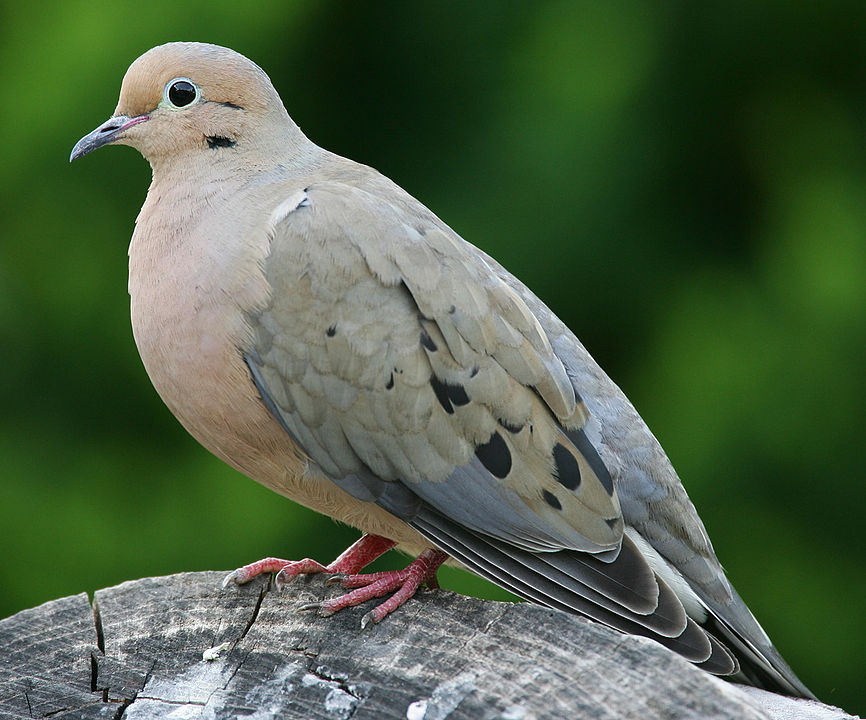
Coloration and Markings: Mourning Doves are easy to identify. They have long wings and tails which are grayish in color, though the wings will have a heavy dose of creamy tan present and some distinctive black spots towards the center of the wings. Some black feathers towards the wingtips also add a ‘layered’ effect when this bird is at rest. The breast and underbelly of this dove are a mix of white and tan, with the tan being heaviest at the breast and turning slowly grayish towards the underbelly. The face of this bird has the heaviest touch of tan and it illustrates, by contrast, the Dove’s white eyering. This bird has a medium-length, straight black bill.
Size: These birds measure in at 9.1 – 13.4 inches in length with wingspans of approximately 17.7 inches.
Habitat: These birds prefer human habitations or at least their proximity and you will almost never find a Mourning Dove in the deep woods. Watch for them in fields, farms, phone wires, or simply strolling down the sidewalk.
Diet: Cracked corn, Black Oil Sunflower seeds, and wheat are all winners with the Mourning Dove. Load up your feeder with one or all of these and you might just get this bird’s attention.
Red-bellied Woodpecker – Melanerpes carolinus

Coloration and Markings: Woodpeckers generally have amazing coloration and the Red-bellied Woodpecker is no exception. The back of this bird and it’s long wings have black and white striping reminiscent of Zebras and this striping continues down to the tops of the short, black tails. The breast and underbelly of this bird are an off-white with some red wash present and a distinctive red spot on the underbelly. Facially, this bird has a mostly white face, with a faint splash of red at the cheeks and a bold, thin red cap that goes from the bill to the back and base of the neck. This bird has a long, straight black bill. When in flight you might also notice some white patches towards the tips of the wingfeathers but they are harder to see at a distance.
Size: These Woodpeckers measure approximately 9.4 inches from head to tail and have wingspans of 13 to 16.5 inches.
Habitat: Oak, Pine, and Hickory stands are great places to find the Red-bellied Woodpecker. They aren’t shy, however, and will happily visit a feeder (especially if you have some trees they like in the backyard).
Diet: Black Oil Sunflower seeds, peanuts, and suet are all considered yummy in this bird’s eyes. Leave it out and see what happens and you should know that their love of sap means they might also visit your Hummingbird feeder as well for a sugary snack.
Tufted Titmouse – Baeolophus bicolor
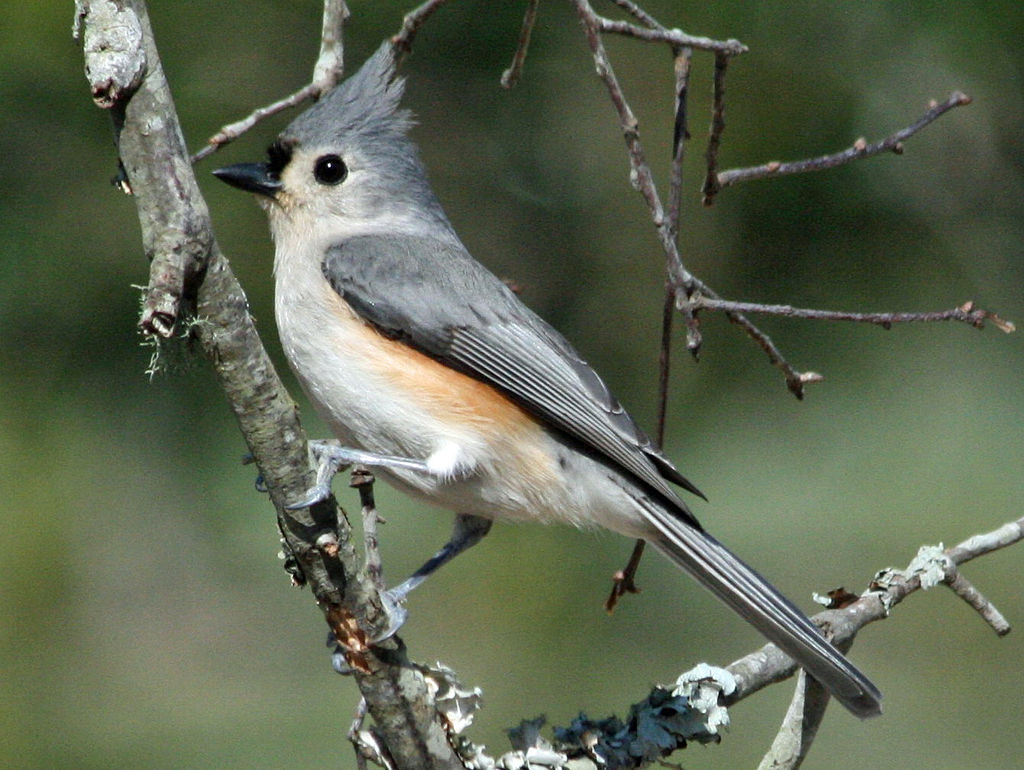
Coloration and Markings: The Tufted Titmouse has a blue-gray back and medium-length blue-gray wings, along with a long, grayish tail. They have a white beast and underbelly, with some peach coloration just under the wings, and the white coloration from the breast carries up to just under the bill and around the eyes. The rest of the face is blue-gray, and you will notice a small, sharp crest as well as a black, squarish mark above the tiny, stout black bill.
Size: Titmice measure in at 5.5 – 6.3 inches in length and have wingspans of 7.9 to 10.2 inches.
Habitat: Evergreen and deciduous woods at lower elevations are the most appealing to the Tufted Titmouse. That said, they range often and won’t hesitate to visit gardens, orchards, and backyards with well-stocked feeders.
Diet: Peanuts and suet will do in a pinch but these guys really love Black Oil Sunflower seeds the best.
American Robin – Turdus migratorius
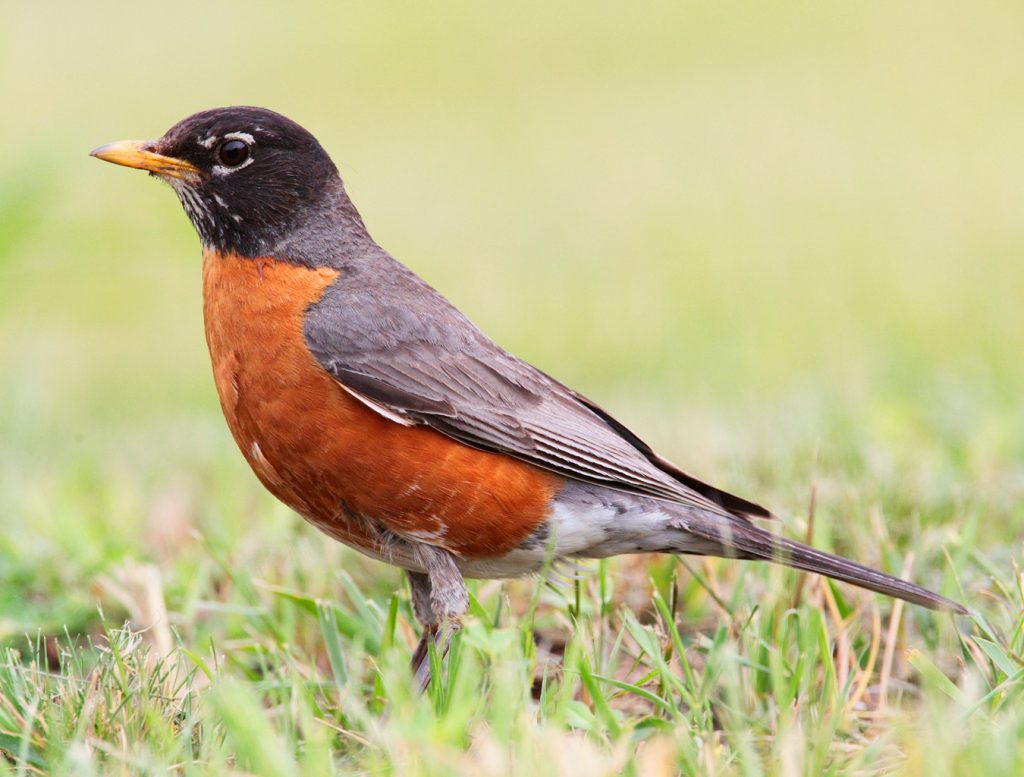
Coloration and Markings: American Robins are very easy to identify and love to visit feeders. They have grayish-brown backs, along with long wings and tail of the same color. You will notice a little white edging in the wings and on the tail as well, the latter of which has some white on the undersides as well which originates at the rump. The breast and underbelly of this bird are a vibrant orange, sometimes with some red added, and facially you will notice that the Robin has a starkly black head. Some minute white may be seen below the bill and a distinct ‘broken’ eyering circles the bird’s eye in fragments. This bird has a medium length, slightly curved yellow bill that often sports a tiny black spot towards the tip. Females have similar coloration but they are dimmer in color, creating less contrast while still remaining quite recognizable.
Size: These birds measure in at 7.9 – 11 inches in length and have wingspans of 12.2 to 15.8 inches.
Habitat: Robins have a healthy dual-citizenship between the woods and the city and so you can see them just about anywhere. In the forest, they prefer deciduous areas and fields are also popular foraging grounds. In the city, they may be seen on phone wires, fence tops, or simply in your backyard sampling the fare you have provided them.
Diet: Mealworms as a main course and a dessert of chopped apples can attract a Robin and often earn you some repeated visits!
Kentucky’s Birds of Spring, Summer, and Early Fall
In March when the Hearts of Gold unfurl their heart-shaped leaves and the Eastern Redbud starts blooming everywhere then you know it is spring in Kentucky. A number of birds start arriving at this time and many stay through summer and into early fall. See if you can spot one of these birds during these times:
- Chimney Swift
- Eastern Wood-Pewee
- Barn Swallow
- Bay-breasted warbler
- Hermit Thrush
Chimney Swift – Chaetura pelagica

Coloration and Markings: Chimney Swifts are child’s-play to identify. They are grayish-brown almost completely, with long wings, short, stubby tails, and a cigar-shape to their body that you can’t miss. Some lighter coloration may be seen at the throat, as well as a white eyebrow mark and black around the eyes in front of the bird’s short, stout, and curved black bill.
Size: Small birds, C-Swifts measure in at 4.7 – 5.9 inches and have wingspans of 10.6 to 11.8 inches in length.
Habitat: These birds fancy enclosed areas, be they hollows in trees, caves, or more urban locales such as air vents or chimneys. They like to be near water when they can as the hunting is quite good there.
Diet: Chimney Swifts are very much insectivores, eating tens of thousands of mosquitos, flies, and other insects each day! Thankfully, their shape makes them easy to spot flying overhead and they might select your chimney for nesting if you are lucky.
Eastern Wood-Pewee – Contopus virens
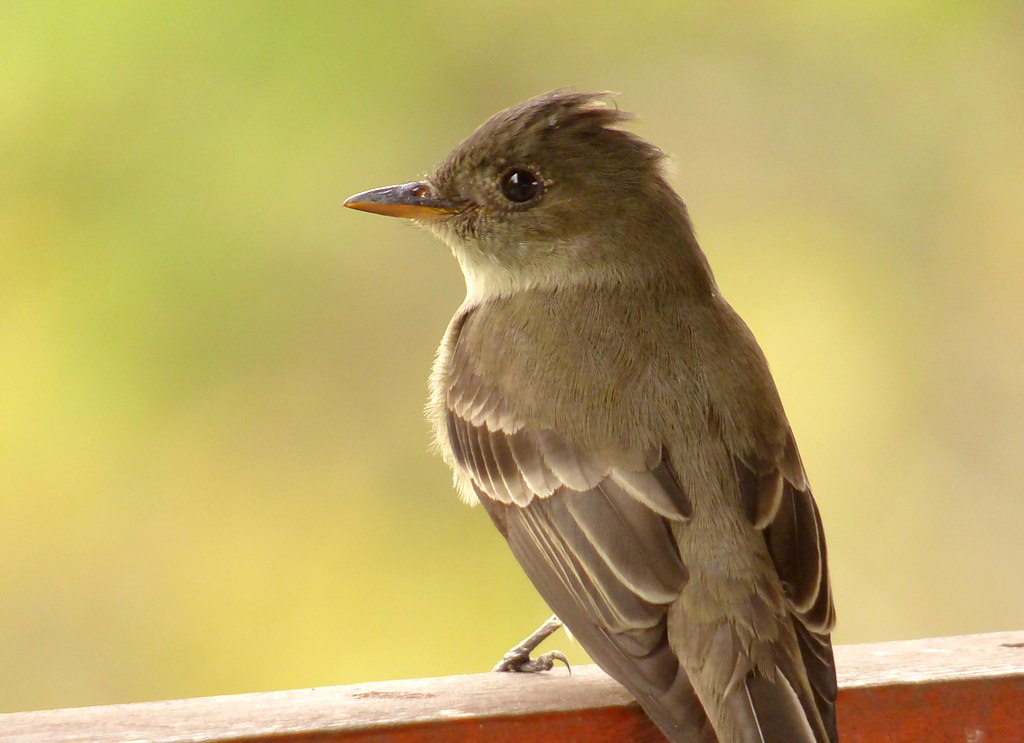
Coloration and Markings: Eastern-wood Peewees look like silent-era film stars. They have olive gray coloration on their backs, with long, dark wings bearing white highlights at some edges, and long, black tails. Their breast and underbelly are a dirty white, with some pure white towards the center of the breast often present, and facially this light gray is carried fro the breast to underneath the chin, under the cheeks, and to the back of the head where it moves up and terminates at the small, dark gray crest. There is darker coloration around the eyes and on the forehead and this bird has long, straight, and ‘dirty’ yellow-orange bill (some faded black is often present at the top). Faint portions of an eyering may be visible and thin wingbars are present which are white in adults and tannish color in juveniles.
Size: Peewees measure in at approximately 5.9 inches from tip to tail and have wingspans of 9.1 to 10.2 inches.
Habitat: These birds love deciduous woods but will willingly range anywhere that there is a collection of trees to keep them feeling safe. If you have a few trees in your backyard this will increases your chances of a feeder visit.
Diet: Go with suet and some berried, with good examples such as chopped cherries, small strawberries, or Blueberries.
Barn Swallow – Hirundo rustica
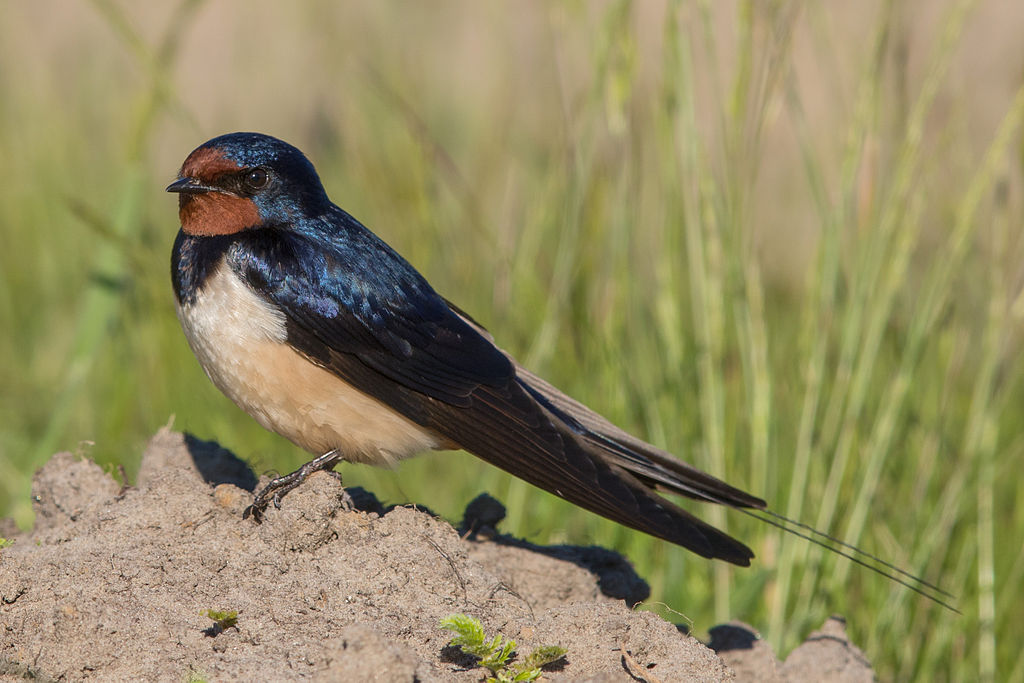
Coloration and Markings: Barn Swallow are Avian superheroes, with dark blue and gray backs and long wings and forked tails of the same color., though a little lightening sometimes is present at the tails making them a little softer gray-blue. The breast and underbelly of this bird are a vibrant orange, much like a Robin’s, with a little white under the wing and you will also notice that blue comes from the shoulders and comes diagonally down onto the breast, as if the blue upper-portion were a cape. The orange coloration is deeper here and sometimes a little red and this color continues up into the face, forming a ‘peak’ that ends just over the bill above but stops at the cheeks below. The remainder of this birds face is a deep, dark blue and the ‘superhero’ look is completed with a diamond-shaped black mask and a short, straight, and sharp black bill. You might see white spots just under the tail when this bird is flying but it’s difficult and we should note that female coloration will be a bit muted, though still arranged to the same design.
Size: These birds measure in at 5.9 – 7.5 inches in length with wingspans of 11.4 to 12.6 inches in width.
Habitat: Barn Swallows like open areas, such as copses, meadows, roadsides, and fields. They do venture into parks and they have a fondness for water, so you can sometimes spot them around marshes or ponds as well.
Diet: These little guys will ignore seeds and suet but may be tempted with offerings or fresh whole or chopped berries.
Bay-breasted warbler – Setophaga castanea

Coloration and Markings: Bay-breasted Warblers are a treat to see. They have gray backs with vertical, zigzag black striping, as well as medium-length gray wings with black edging and 2 distinct white wingbars on each wing. They have medium-length black-edged gray tails and a white breast, underbelly, and rump with the breast having a distinct flanking of rich, rust-red color. This red continues up the face, stopping just under the bill and underlining the cheeks of this bird. The face has black around the eyes which peaks just above the bill at the forehead, circles the eyes and terminates at the underside of the bill. Think of it as a ‘circular mask’. White coloration is also present on the face, starting just in front of the back of the neck above eye level and curving down to stop at the beginning of the cheek. This bird has a long, straight black bill with the upper bill bearing the slightest of curves to it and a distinctive rust-red cap up on top. Females, by extreme contrast, will have yellow-green upper bodies, whitish breast and underbelly, with some faint brownish-red wash sometimes seen at the underbelly. They il have gray and black wings, white rumps, and still bear the distinctive wingbars.
Size: These birds are a humbly-sized, measuring approximately 5.5 inches from head to tail, and they have wingspans of 7.9 to 8.7 inches.
Habitat: These birds love boreal forests and favor coniferous regions, though when it gets chilly they move to tropical areas. These birds will sometimes range to parks and feeders.
Diet: Mostly insectivorous, these little birds may sometimes be tempted with a loaded suet feeder.
Hermit Thrush – Catharus guttatus

Coloration and Markings: Hermit Thrushes are easy to recognize, with a rich brown color on their backs, their long wings, and their perky, long tails. The tails will be almost a fox-red in color. Their breast is a distinctive white covered in black spots, which smudges at the flanks to display an olive-smudge of color which carries on down to the underbelly. These black spots fade going down until they disappear at the underbelly, but going up they continue into the bird’s face, starting under the cheeks and thinning to a point under the bill, with the spots becoming dense and more like stripes in the process. The rest of the face is the same brown as the back, with a thin white eyeline being visible and this bird has a medium-length, straight black and yellow bill.
Size: These Thrushes measure in at 5.5 – 7.1 inches in length and have wingspans of 9.8 to 11.4 inches.
Habitat: These birds love the forest’s edge, meadows, and copses and happily range forth to visit parks and backyard feeders when they are feeling peckish.
Diet: You can tempt a Hermit Thrush more often than not with a triple-combo of suet, raisins, and whole grapes. These little guys love it!
Kentucky’s Fall and Winter Birds
Kentucky winters feature mild days but get a might chilly at nights, with lows around 24 degrees Fahrenheit. A number of birds are nonplussed by this and start ranging out in search of some winter snacks. See if you can lure one of these to your winter feeder:
- Dark-eyed Junco
- Eastern Phoebe
- Purple Finch
- Eastern Meadowlark
- Swamp Sparrow
Dark-eyed Junco – Junco hyemalis

Coloration and Markings: You’ll get some regional variation but the standard color-configuration of a Dark-eyed Junco looks like a dark gray or brown bird with it’s lower body dipped in soft white paint. The back and medium-length wings will be gray or brown, with some minute, white edging, and the long tails will be gray or brown with soft white on the outer feathers and undersides. The beast and underbelly of this bird are white, however heavy gray or brown in a ‘vest’ configuration means you will see white at the center of the breast but the gray things to a small area just under the wings as the white color fills more and more of the lower breast, underbelly, and rump. When the bird is at rest the color looks vertically even, with whitish color at the lower 3rd of the body. Facially, the bird is gray with some darker coloration focused in front of the eyes, and a distinct pink bill that is stout, medium-length, and of conical shape.
Size: Juncos measure 5.5 – 6.3 inches from tip to tail and have wingspans with widths of approximately 7.1 to 9.8 inches.
Habitat: Coniferous and mixed forests are the favored locale for these birds in the warmer months but around winter they like to spend time in parks and backyards.
Diet: These birds love Sunflower hearts, suet, and cracked corn but be sure to use ground feeders. Scatter a little corn on the ground around the feeder as well just to help ensure that you get their attentions.
Eastern Phoebe – Sayornis phoebe

Coloration and Markings: Eastern Phoebes have sharp, lovely coloration. Their backs and medium-length wings are brownish-gray as are their long, notched tails. Their breast and underbelly are a lovely white, with some gray peppered in under the wings and lightly flanking the white down to the underbelly. The white from the breast goes slightly up, enough to until just under chin level, moving horizontally and thinning as it approaches the center of the back, while above this a smooth gray colors the lower face up until mid-eye level where it becomes darker gray with concentrations of black beginning at the forehead to the top of the head and moving horizontally tostop just shy of the back of the head. This bird has straight, a medium-length black bill.
Size: These birds measure in at 5.5 – 6.7 inches in length with wingspans of 10.2 to 11 inches from wingtip to wingtip.
Habitat: Phoebes love open areas, such as the forest’s edge, meadows, copses and yes… nice, open parks or backyards with well-stocked feeders!
Diet: These birds are a little feeder shy but you can sometimes lure them in with a little suet and dried crickets or mealworms.
Purple Finch – Haemorhous purpureus
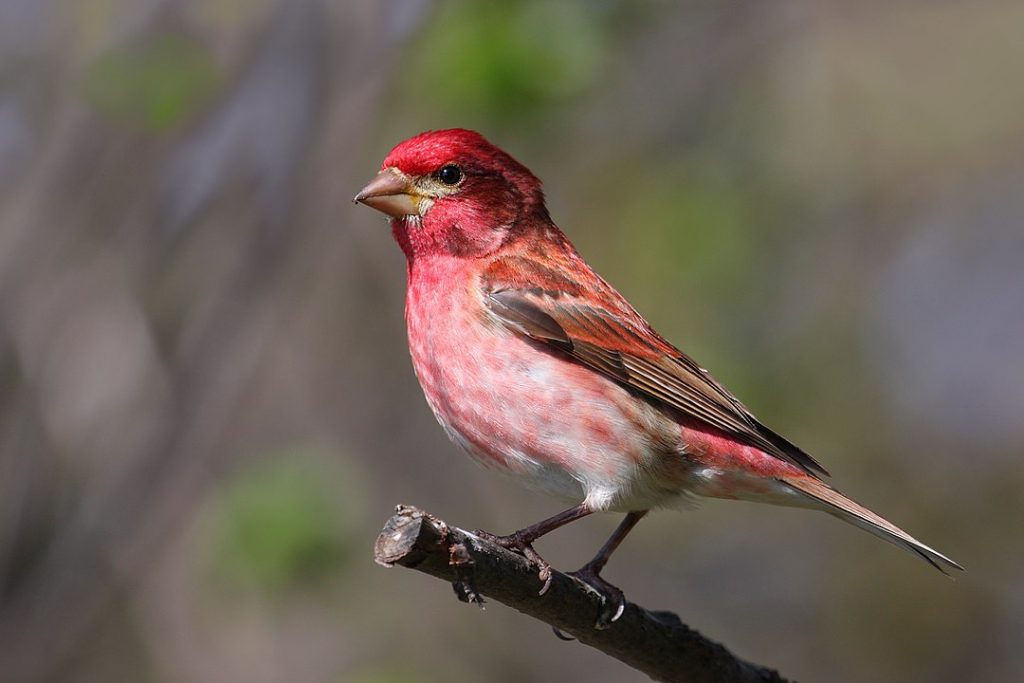
Coloration and Markings: Purple Finches are raspberry rascals, with vibrant raspberry-colored backs with brown in the mix and long brown and purplish wings with some white highlights and 2 thin white wingbars on each wing. They have short, light brown tails with heavy white edging and white underneath. The breast of this bird has light to heavy raspberry coloration which dims as it moves down and becomes faint, raspberry streaking at the underbelly until the rump, where it is completely white. Facially, this bird is a mix of light and dark raspberry, with a thick eyestripe of darker color that curves down around a lighter cheek and lighter pinkish color is also seen in a stripe above the eye and in the area below the bill. Said bill is straight, dirty-yellow, and looks stout enough to crunch fossilized Sunflower seeds. You’ll see what we mean! Females don’t get any of the fancy raspberry coloration but still have the patterning, with heavier streaking and a dark line present at the throat area, and a distinct, white eyestripe.
Size: These birds measure in at 4.7 – 6.3 inches in length and have wingspans of 8.7 – 10.2 inches.
Habitat: Purple Finches prefer coniferous forests with deciduous and coniferous mixes falling as their second choice. They are fond of ranging and may be found in weedy fields, dense shrubby areas, and backyards (especially those with a few bushes).
Diet: Suet, Black Oil Sunflower seeds, and Safflower seeds are great additions to your feeder that Purple Finches will love.
Eastern Meadowlark – Sturnella magna

Coloration and Markings: Eastern Meadowlarks have light brown, dark-streaked backs, short and streaked wings, and perky, medium-length tails which are light brown to sometimes gray. They have a bright yellow breast and underbelly with some inportant distinctions. On the upper breast is a black V-shape, almost like an ‘fancy’necklace, and around the rump and under the wingline is a light, grayish brown and the streaking looks more like spots! Facially, this bird is mostly white, with gray around the cheeks, a black eyeline and crown, and the lower back of the head displays some spots on the white that curves and dwindles at the bird’s ‘V’. This bird has a long, slightly curved silver bill that is often delicately black-edged.
Size: Roughly Robin-sized, these birds measure 7.5 – 10.2 inches in length and have wingspans of 13.8 to 15.8 inches.
Habitat: These birds like open areas, especially fields and areas prone to flooding.
Diet: These birds like grains and seeds when they aren’t eating insects, so try leaving out some oats, wheat, Nyjer thistle, or Black Oil Sunflower seeds if you’d like to get their attentions.
Swamp Sparrow – Melospiza georgiana

Coloration and Markings: Swamp Sparrows have quite interesting coloration. Their backs and short wings are a rusty-red to fox-brown color with black streaking towards the center of the wing that often turns to spots towards the edges. They have medium-length, red-brown tails with some black accents and their breast and underbelly are grayish white with a heavy flanking of an olive-brown mix from the flanks to under the wing. The rump has the same color but looks more ‘spotted’ among in the gray and white and facially things get complex. This bird is whitish under the chin, often with 2 mustache-type marks, the lower one being gray and the upper one is black. A dark eyeline starts behind the eye and towards the back of the head and the area in between this and the mustaches line is a soft foxy brown until just under the eyes. Around the eyes the face is gray, with some white in front of the eye, and the gray curves back over the eye and around to terminate underneath the cheek. This bird has a lovely crown, which is rust-red at the center and capped on the sides with dark black. It also has a medium-length, conical yellow bill that is often black-tipped.
Size: These birds measure in at 4.7 – 5.9 inches in length and have wingspans of 7.1 to 7.5 inches.
Habitat: These birds love brambles and thickets near the water. Look for them in the dense vegetation around ponds, streams, or swamps and you might just spot a Swamp Sparrow.
Diet: Swamp Sparrows may sometimes be tempted with suet, cracked corn, and mixed berries.
Supporting cast (Other Backyard Birds of Kentucky that might pay you a visit)
While they don’t get the front-page billing of our ‘year-round’ birds, this sampling of ‘supporting cast’ birds are still stars and they are available to be seen at any time of the year. Keep an eye out for these guys this year:
- Carolina Chickadee
- European Starling
- Eastern Bluebird
- Eastern Towhee
- Northern Mockingbird
Carolina Chickadee – Poecile carolinensis
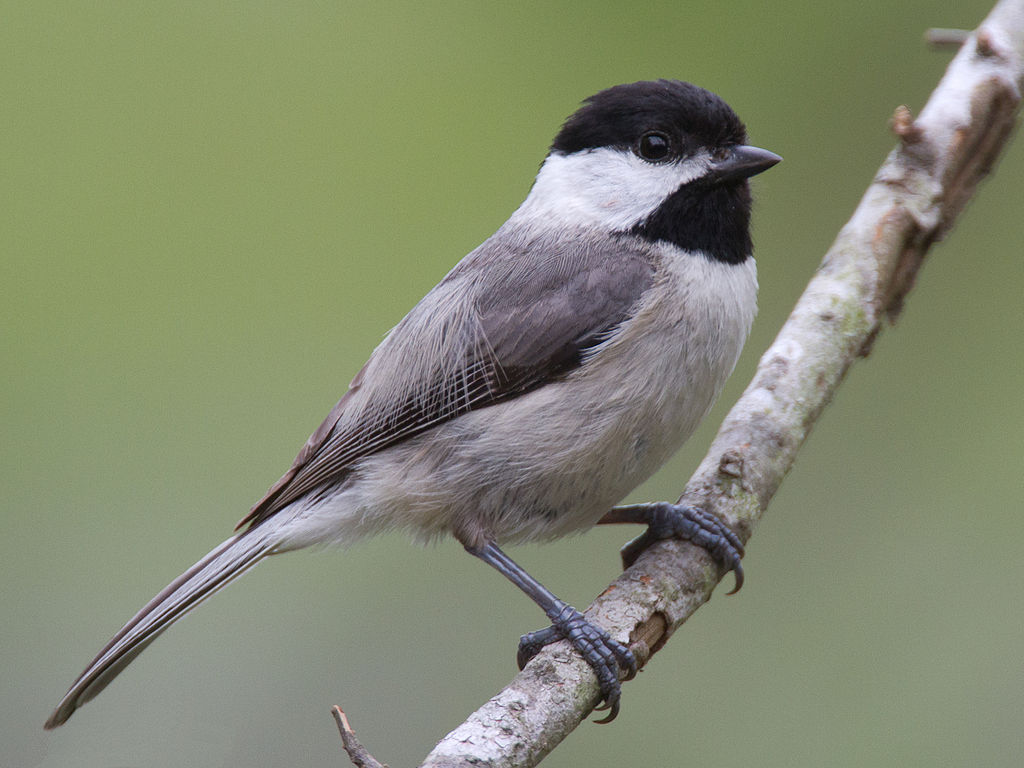
Coloration and Markings: Carolina Chickadees are a breeze to identify. They have gray backs, short gray wings with black highlighting, and long, gray tails. Their breast and underbelly are white, although you will sometimes see a little olive or gray at the underbelly (not always, however), and facially these birds are most recognizable. They have white faces with a black bib and an enormous black cap that terminates at mid-eye level. These bird have tiny, straight, and thick black bills.
Size: These little birds measure in at 3.9 – 4.7 inches from head to tail and have wingspans of 5.9 to 7.9 inches.
Habitat: These birds may be found in parks and woods with equal frequency and are happy to visit backyards as well. Some trees help your odds but if you don’t have them in your backyard, don’t worry, you might still get a visit.
Diet: Suet and chunky peanut butter are exactly what the doctor ordered when you are attempting to lure the Carolina Chickadee.
European Starling – Sturnus vulgaris
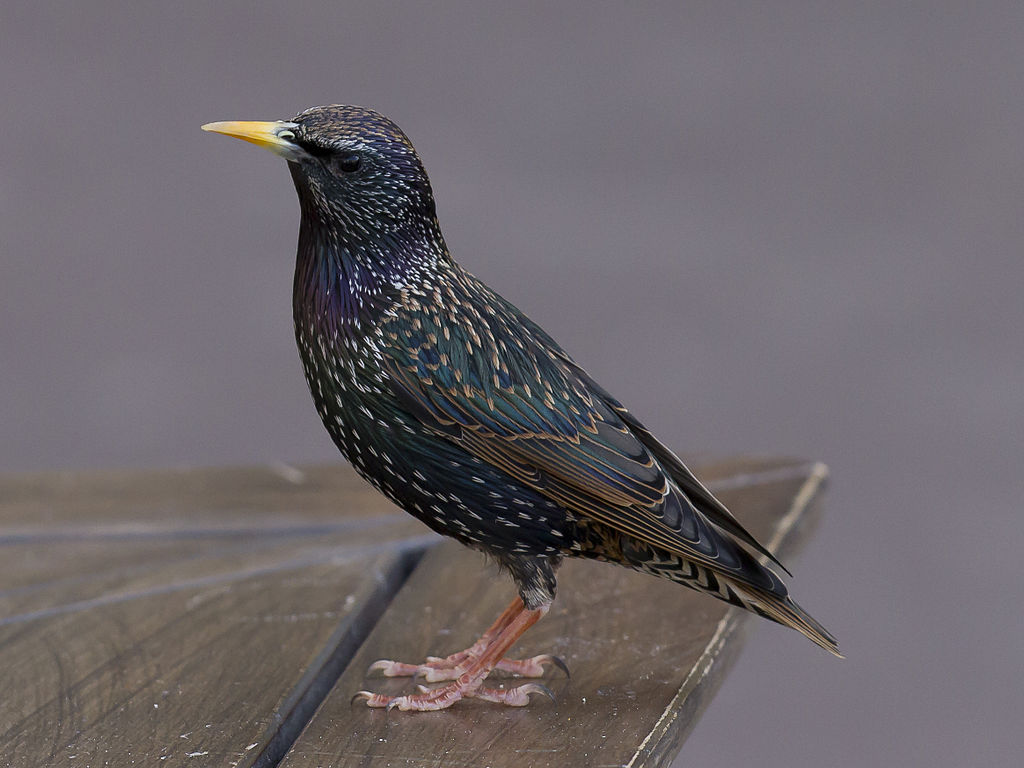
Coloration and Markings: From a distance the European Starling simply looks like a blackbird with a long, straight yellow bill. Up close, things are different, as you will notice that that bird is an ethereal purple and green all over its body and this creates a magical sort of black. They are quite pretty birds, even if not always the most popular. In the winter, they shed their shimmer and adopt a default color of brown with white spotting that you really should see. It’s a drastic and interesting change in plumage you will surely enjoy.
Size: Roughly the same size as a Robin, Starlings measure in at 7.9 – 9.1 inches in length and have wingspans around 12.2 to 15.8 inches in length.
Habitat: These birds learned long ago that humans nearby means that food is also nearby. You’ll see them at granaries (where they are viewed as pests since they can contaminate the store), farms, and all around cities.
Diet: European Starlings love suet and might well eat all the suet cake! Be prepared.
Eastern Bluebird – Sialia sialis
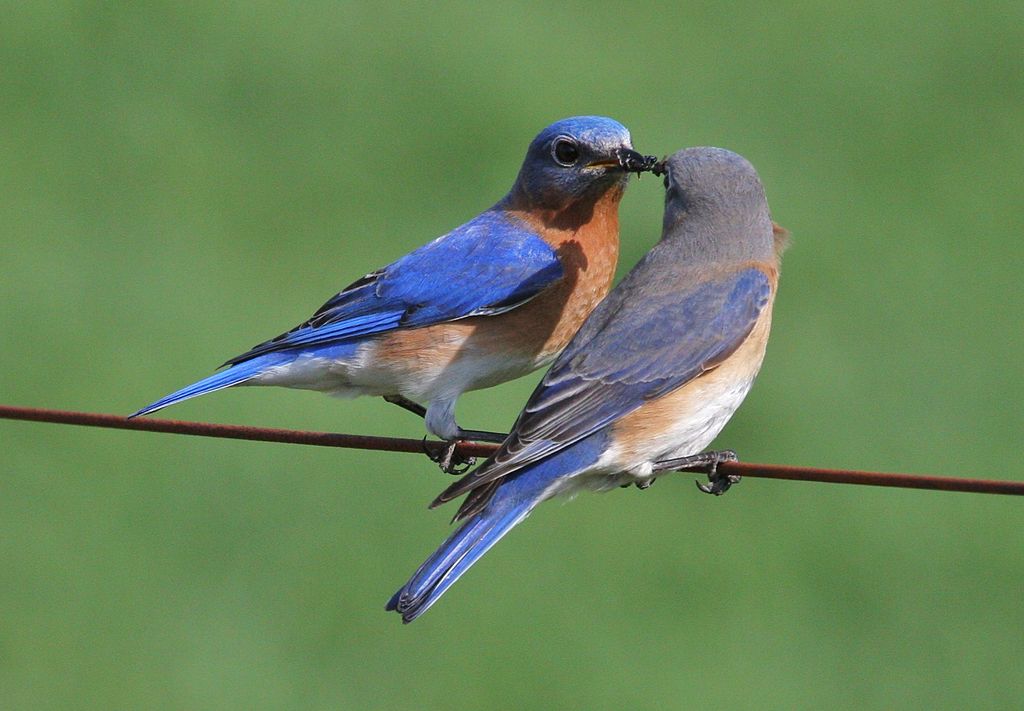
Coloration and Markings: Male Eastern Bluebirds have the most noticeable plumage, with their backs being a deep blue that is also present on their long, black tipped wings, and their medium-length, black-highlighted blue tails. Their breast is a sort of reddish-apricot orange, though white in the center as if the orange is a vest, and as the color moves to the underbelly the orange dwindles to a layer underneath the wings to flank the white underbelly and rump. Some white extends from the rump to the underside of the tail and facially, this bird has orange from the throat that extends horizontally to terminate just before the back of the next and it goes under the bill in in a thin line. The remaining upper portion of the face is blue and this bird has a medium-length, brown to gray bill that is straight but appears slightly curved on the upper bill.
Size: These birds measure in at 6.3 – 8.3 inches in length and have wingspans of 9.8 to 12.6 inches.
Habitat: Open areas such as the forest’s edge, meadows, copses, and even roadsides are attractive to these lovely little thrushes, and they are more than happy to visit a backyard if you make them feel welcome with a gift of appropriate snacks.
Diet: Lots of foods will work with the Eastern Bluebird, such as dried mealworms, suet, or even cornbread! They are easy to please and fun to look at so be sure to stock up the feeder for them and you might just make a new friend.
Eastern Towhee – Pipilo erythrophthalmus

Coloration and Markings: Eastern Towhees are quite distinctive in appearance, rather like ‘gothic Robins’. They have black backs and long, black wings with some white spacess sparsely interspersed to add flavor to the plumage. They have medium-length black tails with some white as well and their breast and underbelly are white in the center with a heavy flanking of orange to orange-red at the sides. Sometimes the white at the rump is flanked with dark lines and facially, this bird has a stark, black head with a small crest, red or black eyes, and medium-length, conical, and stout black bills. Females have the same pattern arrangement but their coloration varies a little, as they wear brown in place of the black you see in the males.
Size: These Robin-sized birds measure in at 6.8 – 8.2 inches in length and have wingspans of 7.9 to 11 inches.
Habitat: These are birds of brushes, brambles, thickets, and thorns. You can see them at the forest’s edge or in backyards that have enough cover to make these birds feel safe and secure.
Diet: You can attract Eastern Towhees with fruit, suet, oats, and dried mealworms. They sometimes even catch small snakes and eat them, so they are nice to have in your backyard!
Northern Mockingbird – Mimus polyglottos

Coloration and Markings: The Northern Mockingbird is easy to identify once you’ve seen one. They have soft, gray backs and shoulders while their wings are gray with 2 white wingbars and black, vertical lines between them and black coloration towards the tips of the wings. When in flight you’ll notice very distinct white patches on these wings. Their tails are gray, with black highlights and white tips and these tails are quite long. The breast and underbelly of this bird are an off-white, with some gray coloration creeping in at the underbelly to make it darker. Facially, the lower half of this bird’s face is mostly white, with a small amount peeking up over the bill, while the upper half is mostly gray. This bird has en eyeline that starts black in front of the eye but becomes soft gray at the back and curves around to frame the cheek. You may also notice a partial white eyering just at the top of the eye. This bird has a medium-length, straight black bill with mild curvature on the top portion of the bill.
Size: Mockingbirds measure in at 8.3 – 10.2 inches in length and have wingspans of 12.2 to 13.8 inches.
Habitat: While they may be seen around the forest’s edge, these birds aren’t shy about people so you’re more likely to spot them in parks, on phone lines, fences, or simply busy gnoshing on what you’ve left for them in the feeder.
Diet: Northern Mockingbirds will load up on suet but you can also give them a sweet treat by halving oranges or chopping up some delicious apples for them.
Kentucky Bird Buffet
One of the ‘holy grail’ type goals that birders have is finding that perfect combination for their feeders that will lure the most diverse and desirable crowd of birds to visit the backyard. We’ve got some recommendations for you of our own and also from ‘Genuine Kentucky’, who has provided a nice article you can find in our reference section with some useful info on food and feeders. Try adding some or all of the following to your backyard feeder array:
- Grape or strawberry jelly
- Suet
- Safflower seeds
- Black Oil Sunflower seeds
- Cracked corn
- Cornbread muffins
Kentucky Birding Hot Spots
If you want to know the hotspots that you can visit around the state then it’s your lucky day. The Chirparazzi know the best places to catch glimpses and photos of our favorite winged celebrities and so we have some locations to share with you for when you are out of the house or if you are not a local, then for when you visit Kentucky. If you don’t find something close, just check our link below and you can search for the closest park or trail based on your address. Here are our recommendations to you:
- Northern hotspot – Newport Southbank Bridge (Purple People Bridge)
- Eastern hotspot – Prestonsburg Passage Rail Trail
- Southern hotspot – Barren River Lake State Resort Park
- Western hotspot – Blackford Pedestrian Bridge
- Central hotspot – South Elkhorn Trail
Detailed descriptions of each location as well as information regarding visiting and what birds you can see at these locations may be found at: https://www.traillink.com/stateactivity/ky-birding-trails/
In Closing
This concludes our exploration of te Kentucky birding scene and we hope that you’ve enjoyed it. Kentucky is a great place for birding and with some patience and a well-stocked feeder then you are sure to enjoy some excellent feathered company. Be sure to check out some of our hotspots if you feel like spending a little time out of the house and until next time, we wish you the best of luck in all your birding!
